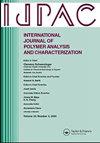Influence of carbon black and cotton fiber on the mechanical and thermal properties of natural rubber composites: a statistical optimization using Central composite design
IF 1.6
4区 工程技术
Q4 POLYMER SCIENCE
International Journal of Polymer Analysis and Characterization
Pub Date : 2025-07-04
DOI:10.1080/1023666X.2025.2495283
引用次数: 0
Abstract
The objective of this study is to enhance the thermal as well as the mechanical properties of vulcanized natural rubber with hybrid reinforcement including alkali-treated cotton fiber and carbon black. The central composite design and response surface methodology techniques were employed to design the experiment and examine optimum mechanical strength with corresponding optimum reinforcement composition. The tensile strength of composites increased from 1.71 to 18.87 MPa as a result of reinforcement. Likewise, the tear strength was improved from 23.20 to 57.91 N/mm. The thermal stability of the composites gets enhanced with the addition of carbon black from 320 °C to 343 °C. FTIR and SEM analysis revealed intercomponent interactions and surface texture of prepared composites. The hybrid reinforcement of cotton fiber and carbon black in the rubber matrix brings out enhancement in mechanical properties as well as the thermal stability of the final composite material. A minute increment in the density of samples was noticed with the addition of cotton fiber and carbon black in the rubber matrix. This increase in density is significantly less than the increase in mechanical strength of composites, which is a good parameter for application purposes of composites.
炭黑和棉纤维对天然橡胶复合材料力学和热性能的影响:基于Central复合材料设计的统计优化
本研究的目的是用碱处理棉纤维和炭黑混合增强剂增强硫化天然橡胶的热性能和力学性能。采用中心复合设计和响应面法进行试验设计,并确定了相应的最佳配筋组合的最佳机械强度。增强后,复合材料的抗拉强度由1.71 MPa提高到18.87 MPa。撕裂强度由23.20 N/mm提高到57.91 N/mm。在320 ~ 343℃范围内加入炭黑,复合材料的热稳定性得到增强。FTIR和SEM分析揭示了复合材料的组分间相互作用和表面织构。在橡胶基体中掺入棉纤维和炭黑,增强了复合材料的力学性能和热稳定性。在橡胶基体中加入棉纤维和炭黑后,样品的密度有微小的增加。这种密度的增加明显小于复合材料机械强度的增加,这对于复合材料的应用目的是一个很好的参数。
本文章由计算机程序翻译,如有差异,请以英文原文为准。
求助全文
约1分钟内获得全文
求助全文
来源期刊
CiteScore
3.50
自引率
5.30%
发文量
37
审稿时长
1.6 months
期刊介绍:
The scope of the journal is to publish original contributions and reviews on studies, methodologies, instrumentation, and applications involving the analysis and characterization of polymers and polymeric-based materials, including synthetic polymers, blends, composites, fibers, coatings, supramolecular structures, polysaccharides, and biopolymers. The Journal will accept papers and review articles on the following topics and research areas involving fundamental and applied studies of polymer analysis and characterization:
Characterization and analysis of new and existing polymers and polymeric-based materials.
Design and evaluation of analytical instrumentation and physical testing equipment.
Determination of molecular weight, size, conformation, branching, cross-linking, chemical structure, and sequence distribution.
Using separation, spectroscopic, and scattering techniques.
Surface characterization of polymeric materials.
Measurement of solution and bulk properties and behavior of polymers.
Studies involving structure-property-processing relationships, and polymer aging.
Analysis of oligomeric materials.
Analysis of polymer additives and decomposition products.

 求助内容:
求助内容: 应助结果提醒方式:
应助结果提醒方式:


